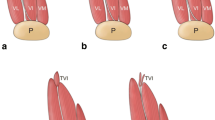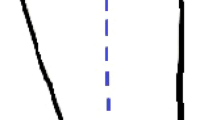Abstract
Purpose
The aim of the present case is to describe an interesting variation of the additional head of the rectus femoris.
Methods
A male body donor, 81 years old at death, was subjected to routine anatomical dissection for research and teaching purposes at the Department of Anatomical Dissection and Donation, Medical University of Lodz, Poland.
Results
We have found an example of an accessory head of the quadriceps femoris, a double-headed rectus femoris in which the proximal attachment is connected to the rectus femoris muscle originating from the anterior inferior iliac spine. The muscle belly of this additional structure is separate but fused distally with the vastus lateralis muscle. It then passes into the patellar ligament inserted into the tibial tuberosity.
Conclusions
Knowledge of the possible occurrence of an additional head is nevertheless important for clinicians, especially for orthopedists performing reconstructive surgeries. It could also be significant for physiotherapists arranging rehabilitation plans after such surgeries because it could potentially help to achieve faster recovery.


Similar content being viewed by others
Availability of data and materials
Please contact authors for data requests (Łukasz Olewnik, PhD—email address: lukasz.olewnik@umed.lodz.pl).
References
Adams DJ, Mazzocca AD, Fulkerson JP (2006) Residual strength of the quadriceps versus patellar tendon after harvesting a central free tendon graft. Arthrosc J Arthrosc Relat Surg 22:76–79. https://doi.org/10.1016/j.arthro.2005.10.015
Bardeen C (1905) Studies of the development of the human skeleton. AmerJ Anat 1905:265–302
Bardeen C (1906) Development and variation of the nerves and the musculature of the inferior extremity and of the neighboring regions of the trunk in man. Am J Anat 1906:259–390
Bardeen C (1906) Development and variation of the musculature of the inferior extremity and the neighboring regions of the trunk in man. Am J Anat 6:259–390. https://doi.org/10.1002/aja.1000060108
Bergman R, Afifi A, Miyauchi R (2017) Illustrated encyclopedia of human anatomic variations, anatomy Atlas. https://www.anatomyatlases.org/AnatomicVariants/MuscularSystem/Text/R/14Rectus.shtml
Bonnechère B, Louryan S, Feipel VT (2020) Quadriceps or pentaceps femoris? Need for proper muscle definition Triceps, quadriceps ou pentaceps femoral ou la nécessité. Morphologie 2020:1–8
Chen CH, Chen WJ, Shih CH (1999) Arthroscopic anterior cruciate ligament reconstruction with quadriceps tendon-patellar bone autograft. J Trauma Inj Infect Crit Care 46:678–682. https://doi.org/10.1097/00005373-199904000-00020
Fink C, Steensen R, Gföller P, Lawton R (2018) Quadriceps tendon autograft medial patellofemoral ligament reconstruction. Curr Rev Musculoskelet Med 11:209–220. https://doi.org/10.1007/s12178-018-9476-1
Franchi T (2020) Tensor vastus intermedius: a review of its discovery, morphology and clinical importance. Folia Morphol (Warsz). https://doi.org/10.5603/fm.a2020.0123
Golland J, Mahon M (1986) Anatomical variations in human quadriceps femoris muscle. J Anat 1986:263–264
Grob K, Ackland T, Kuster MS, Manestar M, Filgueira L (2016) A newly discovered muscle: the tensor of the vastus intermedius. Clin Anat 29:256–263. https://doi.org/10.1002/ca.22680
Grob K, Manestar M, Filgueira L, Ackland T, Gilbey H, Kuster MS (2016) New insight in the architecture of the quadriceps tendon. J Exp Orthop. https://doi.org/10.1186/s40634-016-0068-y
Grob K, Monahan R, Gilbey H, Yap F, Filgueira L, Kuster M (2015) Distal extension of the direct anterior approach to the hip poses risk to neurovascular structures: an anatomical study. J Bone Jt Surg Am 97:126–132. https://doi.org/10.2106/JBJS.N.00551
Holyoke, (1987) An unusual variation in quadriceps femoris. J Anat 1987:227
Iwanaga J, Singh V, Ohtsuka A, Hwang Y, Kim HJ, Moryś J, Ravi KS, Ribatti D, Trainor PA, Sañudo JR, Apaydin N, Şengül G, Albertine KH, Walocha JA, Loukas M, Duparc F, Paulsen F, Del Sol M, Adds P, Hegazy A, Tubbs RS (2021) Acknowledging the use of human cadaveric tissues in research papers: recommendations from anatomical journal editors. Clin Anat 34:2–4. https://doi.org/10.1002/ca.23671
Kang SH, Sohn KM, Lee DK, Lee BH, Yang SW, Wang JH (2020) Arthroscopic posterior cruciate ligament reconstruction: the achilles tendon allograft versus the quadriceps tendon allograft. J Knee Surg 33:553–559. https://doi.org/10.1055/s-0039-1681029
Kennedy MI, Akamefula R, DePhillipo NN, Logan CA, Peebles L, LaPrade RF (2019) Fibular collateral ligament reconstruction in adolescent patients. Arthrosc Tech 8:e141–e145. https://doi.org/10.1016/j.eats.2018.10.007
Lund AT, Amadio PC (2006) Treatment of cubital tunnel syndrome: perspectives for the therapist. J Hand Ther 19:170–179. https://doi.org/10.1197/j.jht.2006.02.003
Moore K, Dalley A (2006) Lower limb. Clinically oriented anatomy. Wilkins, Lippincott Williams and Wilkins, London
Olewnik Ł, Gonera B, Podgórski M, Polguj M, Jezierski H, Topol M (2019) A proposal for a new classification of pes anserinus morphology. Knee Surg Sport Traumatol Arthrosc 27:2984–2993. https://doi.org/10.1007/s00167-018-5318-3
Olewnik Ł, Tubbs RS, Ruzik K, Podgórski M, Aragones P, Waśniewska A, Karauda P, Szewczyk B, Sanudo JR, Polguj M (2021) Quadriceps or multiceps femoris? Cadaveric study. Clin Anat 34:71–81. https://doi.org/10.1002/ca.23646
Tubbs RS, Salter G, Oakes WJ (2004) Femoral head of the rectus femoris muscle. Clin Anat 17:276–278. https://doi.org/10.1002/ca.10186
Tubbs RS, Stetler W, Savage AJ, Shoja MM, Shakeri AB, Loukas M, Salter EG, Oakes WJ (2006) Does a third head of the rectus femoris muscle exist? Folia Morphol (Warsz) 65:377–380
Veeramani R, Gnanasekaran D (2017) Morphometric study of tensor of vastus intermedius in South Indian population. Anat Cell Biol 50:7–11. https://doi.org/10.5115/acb.2017.50.1.7
Waligora AC, Johanson NA, Hirsch BE (2009) Clinical anatomy of the quadriceps femoris and extensor apparatus of the knee. Clin Orthop Relat Res 467:3297–3306. https://doi.org/10.1007/s11999-009-1052-y
Willan PL, Mahon M, Golland JA (1990) Morphological variations of the human vastus lateralis muscle. J Anat 168:235–239
Acknowledgements
The authors sincerely thank those who donated their bodies to science so that anatomical research could be performed. Results from such research can potentially increase mankind’s overall knowledge that can then improve patient care. Therefore, these donors and their families deserve our highest gratitude [15].
Funding
The authors have no financial or personal relationship with any third party whose interests could be influenced positively or negatively by the article’s content. This research received no specific grant from funding agencies in the public, commercial, or not-for-profit sectors.
Author information
Authors and Affiliations
Corresponding author
Ethics declarations
Conflict of interests
The authors declare that they have no competing interests.
Ethical approval and consent to participate
The study protocol was accepted by the Bioethics Committee of the Medical University of Lodz. The cadavers were the property of the Department of Anatomical Dissection and Donation, Medical University of Lodz, and of the Donors and Dissecting Rooms Center, Universidad Complutense de Madrid, Spain. Informed consents were obtained from all participants before they died.
Consent to publish
Not applicable.
Additional information
Publisher's Note
Springer Nature remains neutral with regard to jurisdictional claims in published maps and institutional affiliations.
Rights and permissions
About this article
Cite this article
Zielinska, N., Balcerzak, A., Tubbs, R.S. et al. Additional head of the rectus femoris muscle: a case report. Surg Radiol Anat 44, 829–834 (2022). https://doi.org/10.1007/s00276-022-02937-4
Received:
Accepted:
Published:
Issue Date:
DOI: https://doi.org/10.1007/s00276-022-02937-4




